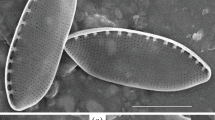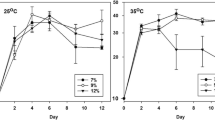Abstract
Navicula sp. (cf.N. tenelloides) was isolated from a salt marsh in Kuwait. The alga grew best with 0.5M NaCl, but abundant growth still occurred up to 2.5M NaCl. The total lipid content and the carotene to chlorophyll ratio of the cells increased with increasing salinity of the medium from 0.5 to 1.7M NaCl, but declined with 2.5M NaCl. Irrespective of the medium salinity, the major lipid class was that of triacylglycerols. The predominant fatty acids in the total lipids of cells grown at different NaCl concentrations were palmitic (16:0) and palmitoleic (16:1) acids; eicosapentaenoic acid (20:5) made up 8–9% of the total fatty acids. The fatty acid composition of the individual lipid classes of cells grown at different salinities is described. The highest concentration of 20:5 occurred in monogalactosyldiacylglycerols and digalactosyldiacylglycerols. In view of the rather small size of this diatom, its halotolerance and its fair content of 20:5, it is suggested as a potential food source for the mariculture industry.
Similar content being viewed by others
References
Archibald REM (1983) The diatoms of the Sundays and Great Fish Rivers in the eastern Cape Provence of South Africa. Bibliotheca Diatomologica 1, 432 pp.
Borowitzka MA (1988) Fats, oils and hydrocarbons. In: Borowitzka MA, Borowitzka LJ (eds), Micro-algal Biotechnology. Cambridge University Press, Cambridge, 257–287.
Chalvardjian A (1964) Fatty acids of brown and yellow fat in rats. Biochem. J. 90: 518–521.
De Mort CI, Lowry R, Tinsley I, Phinney HK (1972) The biochemical composition of some estuarine phytoplankton species. I. Fatty acid composition. J. Phycol. 8: 211–216.
Dittmer JC, Lester RL (1964) A simple specific spray for the detection of phospholipids on this layer chromatograms. J. Lipid Res. 5: 126–127.
Enright CT, Newkirk GF, Craigie JS, Castell JD (1986a) Evaluation of phytoplankton as diets for juvenileOstrea edulis L. J. Exp. Mar. Biol. Ecol. 96: 1–13.
Folch J, Lees M, Sloane Stanley GH (1957) A simple method for the isolation and purification of total lipids from animal tissue. J. Biol. Chem. 226: 497–509.
Fontana DR, Haug A (1982) Effects of sodium chloride on the plasma membrane of halotolerantDunaliella primolecta: an electron spin resonance study. Arch. Microbiol. 131: 184–190.
Garland CD (1988). Australian mariculture: the role of hatcheries in animal production. TASUNI Research, University of Tasmania, Hobart, 16 pp.
Guillard RRL, Ryther JH (1962) Studies of marine planktonic diatoms. I.Cyclotella nana Hustedt andDetonula confervacea (Cleve) Gran. Can. J. Microbiol. 8: 229–239.
Hansmann E (1973) Pigment analysis. In: Stein JR (ed.), Handbook of Phycological Methods. Culture Methods and Growth Measurements. Cambridge University Press, Cambridge, 359–368.
Hasle GR, Fryxell GA (1970) Diatoms: Cleaning and mounting for light and electron microscopy. Trans. Am. microsc. Soc. 89: 469–474.
Helm MM, Laing I (1987) Preliminary observations on the nutritional value of ‘TahitiIsochrysis’ to bivalve larvae. Aquaculture 62: 281–288.
Jeffrey SW, Garland CD (1987) Mass culture of microalgae essential for mariculture hatcheries. Aust. Fish. 46 (5): 14–18.
Kanazawa A (1985) Nutrition of penaeid prawns and shrimps. In: Taki Yet al. (eds), Proc. 1st Int. Con. Cult. Penaeid Prawns/Shrimps. South Asian Fisheries Development Centre, Iloilo, Philippines, 123–130.
Kanazawa A, Teshima SI, Kazuo O (1979) Relationship between essential fatty acid requirements of aquatic animals and the capacity for biooonversion of linolenic acid to highly unsaturated fatty acids. Comp. Biochem. Physiol. 63B: 295–298.
Laing I, Millican PF (1986) Relative growth and growth efficiency ofOstrea edulis L. spat fed various algal diets. Aquaculture 54: 245–262.
Lee YK, Tan HM, Low CS (1989) Effect of salinity of medium on cellular fatty acids composition of marine algaPorphyridium cruentum (Rhodophyceae). J. appl. Phycol. 1: 19–23.
Mangold HK, Malins DC (1960) Fractionation of fats, oil and waxes on thin layers of silicic acid. J. Am. Oil Chem. Soc. 37: 383–385.
Miwa TK, Mikolajezak KL, Earle FR, Wolff IA (1960). Gas chromatographic characterization of fatty acids. Identification constants for mono- and dicarboxylic methyl esters. Anal. Chem. 32: 1739–1742.
Nichols BW (1984) Separation of plant phospholipids and glycolipids. In: James AT, Morries LJ (eds), New Biochemical Separations. Von Nostrand Company, London, 221–237.
Nichols PD, Pamisano AC, Smith GA, White DC (1986) Lipids of the Antarctic sea ice diatomNitzschia cylindrus. Phytochem. 25: 1649–1653.
Orcutt DM, Patterson GW (1974) Effect of light intensity upon lipid composition ofNitzschia closterium (Cylindrotheca fusiformis). Lipids 9: 1000–1003.
Parsons TR, Strickland JDH (1965) Particulate organic matter. III.I. Pigment analysis. III.II. Determination of Phytoplankton pigments. J. Fish. Res. Bd Can. 18: 117–127.
Pillsbury KS (1985) The relative food value and biochemical composition of five phytoplankton diets for the queen conch,Strombus gigas (Linne) larvae. J. exp. mar. Biol. Ecol. 90: 221–231.
Quinn PJ, Williams WP (1983) The structural role of lipids in photosynthetic membranes. Biochim. Biophys. Acta 737: 223–266.
Radwan SS (1978) Coupling of two dimensional thin-layer chromatography with gas chromatography for the quantitative analysis of lipid classes and their constituent fatty acids. J. Chromatogr. Sci. 16: 538–542.
Radwan SS (1984) Glycerophospholipids. In: Zweig G, Sherma J, Mangold HK (eds), CRC Handbook of Chromatography, Lipids. Boca Raton, Florida, 1: 481–508.
Rodgers LJ, Barlow CG (1987) Better nutrition enhances survival of barramundi larvae. Aust. Fish. 46 (7): 30–32.
Siakotos AN, Rouser G (1965) Analytical separation of nonlipid water soluble substances and gangliosides from other lipids by dextran gel column chromatography. J. Am. Oil Chem. Soc. 42: 913–919.
Verity PG, Smayda TJ (1989) Nutritional value ofPhaeocystis pouchetii (Prymnesiophyceae) and other phytoplankton forAcartia spp. (Copepoda): ingestion, egg production and growth of nauplii. Mar. Biol. 100: 161–171.
Volkman JK, Jeffry SW, Nichols PD, Rogers GI, Garland CD (1989) Fatty acid and lipid composition of 10 species of microalgae used in mariculture. J. exp. mar. Biol. Ecol. 128: 219–240.
Author information
Authors and Affiliations
Rights and permissions
About this article
Cite this article
Al-Hasan, R.H., Ali, A.M., Ka'wash, H.H. et al. Effect of salinity on the lipid and fatty acid composition of the halophyteNavicula sp.: potential in mariculture. J Appl Phycol 2, 215–222 (1990). https://doi.org/10.1007/BF02179778
Received:
Revised:
Accepted:
Issue Date:
DOI: https://doi.org/10.1007/BF02179778




